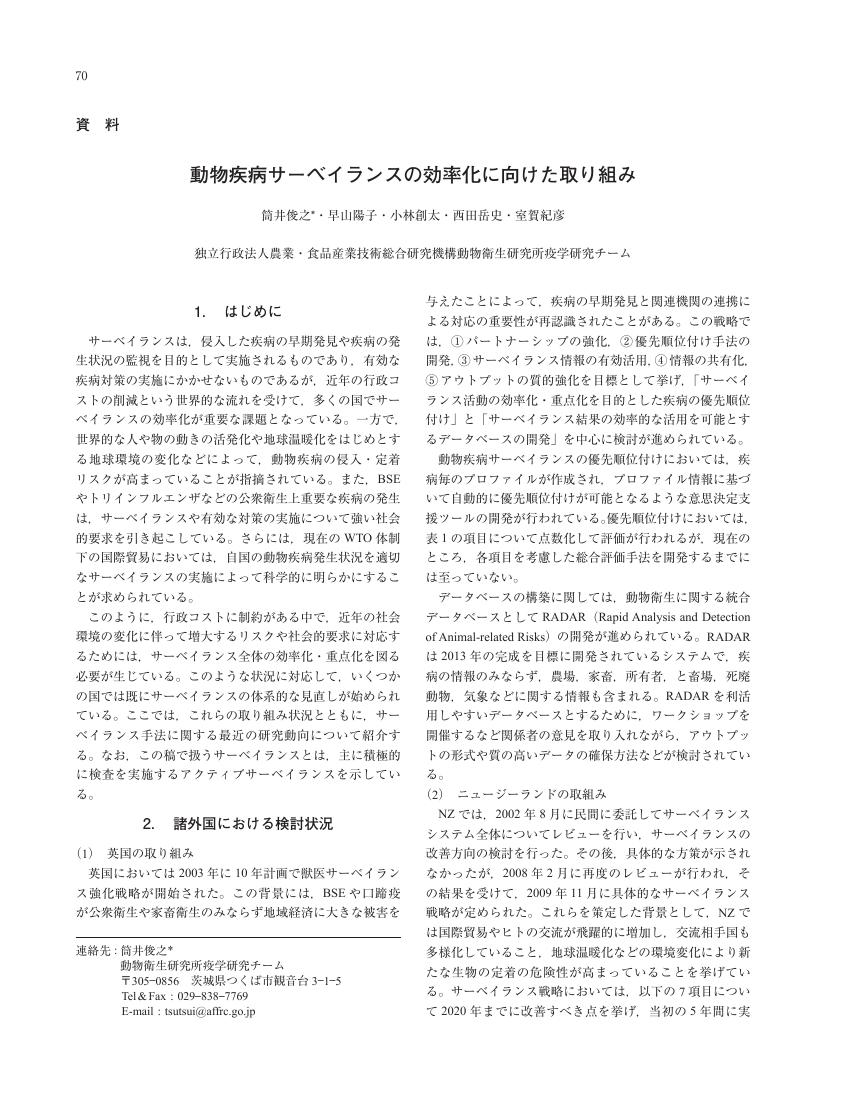69 0 0 0 OA 2010年に宮崎県で発生した口蹄疫について:
5 0 0 0 OA 動物疾病サーベイランスの効率化に向けた取り組み
2 0 0 0 OA 口蹄疫の汎用型伝播シミュレーターの開発
- 著者
- 早山 陽子 山本 健久 筒井 俊之
- 出版者
- 獣医疫学会
- 雑誌
- 獣医疫学雑誌 (ISSN:13432583)
- 巻号頁・発行日
- vol.22, no.2, pp.93-101, 2018-12-20 (Released:2019-07-01)
- 参考文献数
- 29
Foot-and-mouth disease (FMD) is a highly contagious and economically important disease of cloven-hoofed animals. Epidemiological modeling has been recognized as a useful tool for studying the spread of the disease under different environments and control measures. In this study, we developed an FMD transmission simulator (Japan simulation model of animal infectious diseases simulator FMD, JSMIN-FMD), which is a user-friendly simulation system, allowing decision makers to use for evaluation of the effectiveness and efficacy of control strategies upon the simulated outbreaks. This simulator employs a stochastic spatially explicit individual-based model to generate between-farm transmission in a selected area. To run the simulator, farm data including farm sizes, animal species, and geographical locations, is required. Parameters concerning the transmission process and control measures are also necessary. The transmission process is composed of two parts, namely transmission before the movement restrictions and that after movement restrictions. Long-distance transmissions were generated reflecting the movement of animals, humans, and vehicles in the area. The default setting parameters of these movement patterns such as the frequency and distance of movements were based on the survey results conducted in the livestock farming areas. Estimation of the movement distance is also available based on the farm density in the simulated area by a developed algorithm. Local spread was produced by transmission kernels estimated from the previous FMD epidemics in Japan in 2010 and those in Europe in 2001. Control measure scenarios include prompt culling, preemptive culling, and vaccination. For simulating these scenarios, culling or vaccinating capacities and prioritization of farms to be culled or vaccinated can be defined in advance. Simulation outputs include graphs and tables on epidemic size, economic impact, and required human resources as well as maps showing the way of the disease spread. The simulator could provide practical help for decision makers to understand how the disease spread and how best to control the disease in planning control strategies against FMD.
1 0 0 0 OA 数理モデルを用いたエボラウイルス感染症の流行の解析
- 著者
- 山本 健久 早山 陽子 筒井 俊之
- 出版者
- 獣医疫学会
- 雑誌
- 獣医疫学雑誌 (ISSN:13432583)
- 巻号頁・発行日
- vol.19, no.1, pp.48-54, 2015-07-20 (Released:2016-01-04)
- 参考文献数
- 17
We developed a deterministic mathematical model to grasp transmission features of the large scale epidemic of Ebola virus disease (EVD) occurred in the West African region since March 2014. Basic reproduction number (R0) was estimated as 1.32, and the number of days between clinical onset and isolation into caretaking facilities was estimated as 5.0 days. If the days to isolation was less than 3.3 days, the epidemic was considered to be successfully controlled.

